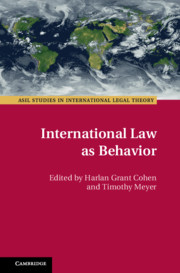30 results
Introduction to the Symposium on Gregory Shaffer, “Governing the Interface of U.S.-China Trade Relations”
- Part of
-
- Journal:
- AJIL Unbound / Volume 116 / 2022
- Published online by Cambridge University Press:
- 14 February 2022, pp. 38-40
-
- Article
-
- You have access
- Open access
- HTML
- Export citation
2 - Are We (Americans) All International Legal Realists Now?
- from I - The Idea of International Law in the Divided West
-
-
- Book:
- Whither the West?
- Published online:
- 29 April 2021
- Print publication:
- 29 April 2021, pp 33-52
-
- Chapter
- Export citation
Dedication
-
- Book:
- International Law as Behavior
- Published online:
- 15 March 2021
- Print publication:
- 01 April 2021, pp vii-viii
-
- Chapter
- Export citation
Index
-
- Book:
- International Law as Behavior
- Published online:
- 15 March 2021
- Print publication:
- 01 April 2021, pp 285-296
-
- Chapter
- Export citation
Appendix A - Methodology
- from 7 - Transnational Collaborations in Transitional Justice
-
- Book:
- International Law as Behavior
- Published online:
- 15 March 2021
- Print publication:
- 01 April 2021, pp 182-184
-
- Chapter
- Export citation
Appendix B - Interview Indexes
- from 7 - Transnational Collaborations in Transitional Justice
-
- Book:
- International Law as Behavior
- Published online:
- 15 March 2021
- Print publication:
- 01 April 2021, pp 185-190
-
- Chapter
- Export citation
1 - International Law As Behavior
-
-
- Book:
- International Law as Behavior
- Published online:
- 15 March 2021
- Print publication:
- 01 April 2021, pp 1-18
-
- Chapter
- Export citation
Tables
-
- Book:
- International Law as Behavior
- Published online:
- 15 March 2021
- Print publication:
- 01 April 2021, pp xi-xi
-
- Chapter
- Export citation
Acknowledgments
-
- Book:
- International Law as Behavior
- Published online:
- 15 March 2021
- Print publication:
- 01 April 2021, pp xiii-xiv
-
- Chapter
- Export citation
Contributors
-
- Book:
- International Law as Behavior
- Published online:
- 15 March 2021
- Print publication:
- 01 April 2021, pp xii-xii
-
- Chapter
- Export citation
Contents
-
- Book:
- International Law as Behavior
- Published online:
- 15 March 2021
- Print publication:
- 01 April 2021, pp ix-x
-
- Chapter
- Export citation
Copyright page
-
- Book:
- International Law as Behavior
- Published online:
- 15 March 2021
- Print publication:
- 01 April 2021, pp vi-vi
-
- Chapter
- Export citation

International Law as Behavior
-
- Published online:
- 15 March 2021
- Print publication:
- 01 April 2021
Introduction to the Symposium on Julian Nyarko, “Giving the Treaty a Purpose: Comparing the Durability of Treaties and Executive Agreements”
- Part of
-
- Journal:
- AJIL Unbound / Volume 113 / 2019
- Published online by Cambridge University Press:
- 28 May 2019, pp. 169-172
-
- Article
-
- You have access
- Open access
- HTML
- Export citation
What Is International Trade Law For?
-
- Journal:
- American Journal of International Law / Volume 113 / Issue 2 / April 2019
- Published online by Cambridge University Press:
- 09 April 2019, pp. 326-346
- Print publication:
- April 2019
-
- Article
-
- You have access
- HTML
- Export citation
Not Enough: Human Rights in an Unequal World. By Samuel Moyn. Cambridge, Massachusetts: Harvard University Press, 2018. Pp. ix, 220. Index.
-
- Journal:
- American Journal of International Law / Volume 113 / Issue 2 / April 2019
- Published online by Cambridge University Press:
- 09 April 2019, pp. 415-419
- Print publication:
- April 2019
-
- Article
- Export citation
Part II - Legitimacy – Cross-Cutting Issues
-
- Book:
- Legitimacy and International Courts
- Published online:
- 05 February 2018
- Print publication:
- 22 February 2018, pp 305-371
-
- Chapter
- Export citation
Contributors
-
- Book:
- Legitimacy and International Courts
- Published online:
- 05 February 2018
- Print publication:
- 22 February 2018, pp vii-viii
-
- Chapter
- Export citation
Copyright page
-
- Book:
- Legitimacy and International Courts
- Published online:
- 05 February 2018
- Print publication:
- 22 February 2018, pp iv-iv
-
- Chapter
- Export citation
Part I - The Legitimacy of Particular Dispute Settlement Mechanisms
-
- Book:
- Legitimacy and International Courts
- Published online:
- 05 February 2018
- Print publication:
- 22 February 2018, pp 41-304
-
- Chapter
- Export citation



